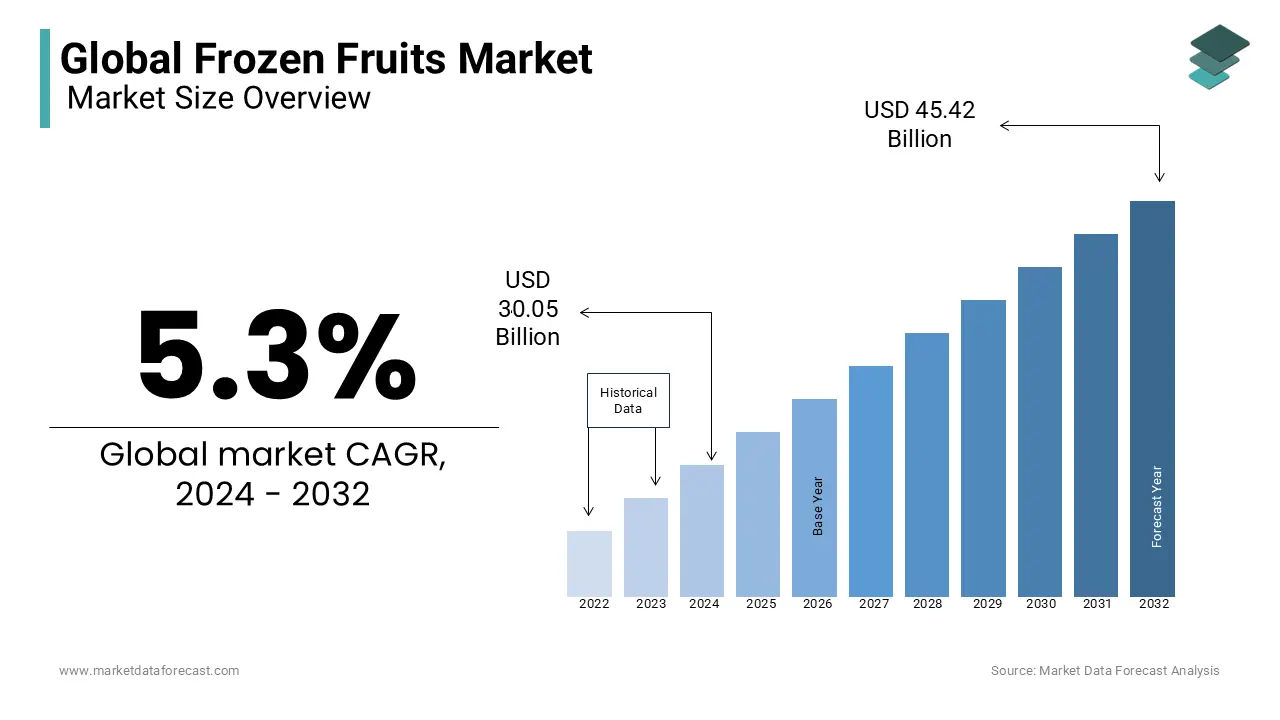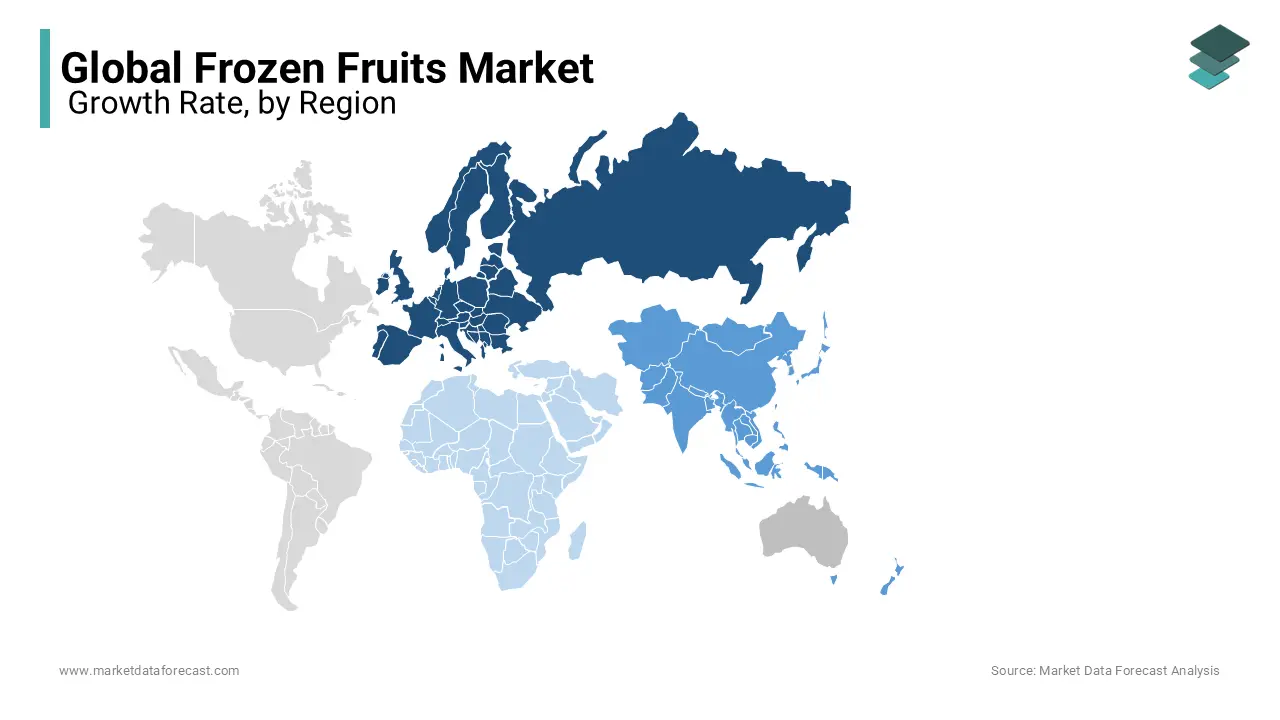Global Frozen Fruits Market Size, Share, Trends & Growth Forecast Report – Segmented By Product Type (Citrus Fruits, Red Fruits & Berries and Tropical Fruits), Technique (Freeze Drying and IQF), Application (Confectionery & Bakery, Jams & Preserves, Fruit-based Beverages, Dairy, and Others), And Region (North America, Europe, Asia Pacific, Latin America, and Middle East & Africa) - Industry Analysis (2025 to 2033)
Global Frozen Fruits Market Size
The size of the global frozen fruits market size was assessed to be USD 30.05 billion in 2024. The global market is further expected to grow at a CAGR of 5.3% from 2025 to 2033 and be valued at USD 47.83 billion by 2033 from USD 31.64 billion in 2025. Frozen fruits have been kicked out of the food category immediately as the demand for convenience is increasing worldwide.

Frozen fruit is a convenient and healthy food. Frozen fruits easily retain the flavor, nutritional value, and texture of food. They are popular with consumers and are readily available on the market at low prices. Frozen fruit refers to fruits that have been chilled and kept below freezing for storage and transportation until ready to eat. Additionally, they can be commercially packaged or frozen at home. In addition to this, various frozen fruits are sold in supermarkets and hypermarkets. Various types of frozen fruits include ready-to-eat foods, fruit juices, smoothies, salads, and other fruits, which are the most famous products in the world. Freezing is among the most common methods employed to preserve food. Through this process, you can preserve the texture, taste, and nutritional value of food. The freezing process reduces the chemical reaction, slows down cellular metabolic reactions and has the advantage of low temperatures that microorganisms cannot develop. The freezing process is used for the long-term preservation of various foods and vegetables, which provides a long shelf life. This includes reducing the product temperature to below -18°C. The physical state of the food changes because the fruit cools to freezing temperature to remove energy. Extreme cold temperatures decrease chemical changes that delay microbial growth and affect product quality.
MARKET DRIVERS
Frozen fruits are gaining popularity with consumers because they offer many advantages over fresh produce.
Frozen fruits revitalized the industry as awareness of the nutritional value of frozen fruits and vegetables increases and clean eating habits increase. In addition, a systematic supply of frozen fruit nets has been developed as technological developments have increased along with improvements in the refrigeration chain in emerging countries. Other factors that have a positive impact on the global frozen fruit market include urbanization, rapidly changing consumer lifestyles, increased disposable income, and active marketing by manufacturers. Demand has increased due to consumer consumption patterns and increasingly busy lifestyle changes. Industrial growth was also supported by the rising call for new flavors and ingredients in products. Countries that lack fresh fruit prefer frozen fruit because the frozen process preserves food and does not use unwanted additives in frozen food bags such as strawberries and spinach. Also, the increased demand for frozen fruits in different parts of the world due to the large population and busy lifestyles worldwide is another factor driving growth in the global market during the outlook period.
The rising preference for frozen fruits from consumers due to the benefits associated is further boosting the global market growth.
Consumers have been increasingly wanting frozen fruits due to various benefits, such as shorter cooking time, convenience, no need to peel, wash and cut, etc. In addition, as the popularity of a variety of foods that are easy to cook around the world increases, the demand for frozen fruits is expected to increase, accelerating world market growth during the forecast period. In addition to this, the development of cold chain logistics is expected to be a dynamic factor in the growth of the global frozen fruit market. Besides, with the increase in the number of working populations, women are expected to precisely increase their consumption of frozen fruits, offsetting the growth of the global frozen fruit market during the forecast period. Also, the number of technologies used for frozen fruit increases with aggressive marketing by manufacturers worldwide, and the increased prevalence of frozen fruit on e-commerce portals is another factor driving the growth of the world market in the next few years. Nonetheless, increased demand in countries where fresh fruit is scarce is one of the main factors that can create profitable opportunities in the near future.
MARKET RESTRAINTS
The easy availability of frozen fruit alternatives on the market is an important deterrent to the growth of the global market. The problem with high-moisture fruits, which can become food or pulp when thawed, is one of the main factors limiting the growth of the frozen fruit market during the forecast period.
REPORT COVERAGE
|
REPORT METRIC |
DETAILS |
|
Market Size Available |
2024 to 2033 |
|
Base Year |
2024 |
|
Forecast Period |
2025 to 2033 |
|
CAGR |
5.3% |
|
Segments Covered |
By Type, Technique, Application, and Region |
|
Various Analyses Covered |
Global, Regional, & Country Level Analysis; Segment-Level Analysis, DROC, PESTLE Analysis, Porter’s Five Forces Analysis, Competitive Landscape, Analyst Overview of Investment Opportunities |
|
Regions Covered |
North America, Europe, APAC, Latin America, Middle East & Africa |
|
Market Leaders Profiled |
Pinnacle Foods Inc., Welch Foods, Ardo NV, SunOpta Inc., Kendall Frozen Fruits Inc., Uran Food Group Limited, Kerry Group Plc, Nestlé, ConAgra Foods Inc. and General Mills. |
SEGMENTAL ANALYSIS
Global Frozen Fruits Market Analysis By Product Type
The citrus fruits segment is engraved in holding the dominant share of the market, whereas the red fruits & berries segment is likely to have the dominant growth rate during the forecast period. The rising awareness of the benefits of citrus fruits is a major factor that is prompting the demand for these fruits across the world. In international trade, the demand for the production of citrus fruits is huge, as they are the highest-value fruit crop. These fruits are a key source of vitamin C, which is essential in maintaining healthy diet options. Tropical fruits have also been gaining huge popularity in recent times, and they are likely to have a positive growth rate in the coming years.
Global Frozen Fruits Market Analysis By Technique
The freeze drying segment holds the dominant share of the market, whereas IQF shall have the essential growth rate during the forecast period. The freeze-drying technique probably increases the shelf life of the fruits for many years by removing 98-99% of the moisture during the process. The removal of moisture from the fruits shall extend their overall shelf life and help transport them from one place to another with proper packaging. This extends the quality of the citrus fruits, which is likely to improve the growth rate of the market. IQF (Individual Quick Freezing) is a technique where every individual fruit is stored under -30°C to -40°C temperature, ensuring that it does not stick with the others. The process substantially increases the prominence of using the fruits even after 24 months with the same freshness.
Global Frozen Fruits Market Analysis By Application
Confectionery & bakery segment is holding the largest share of the frozen fruits market. Consumer’s interest towards different flavored bakery products using fruits is attributed in levelling up the growth rate of the market. Jams & Preserves segment is likely to have the highest CAGR by the end of forecast period. In modern era, people are more likely to rely on the ready to eat or fast food products due to lack of time to cook freshly home made food products which is substantially to increase the demand for the various fruit flavored products.
REGIONAL ANALYSIS

Europe and North America are expected to have a large share of the global frozen fruit and vegetable market through the end of the forecast period. The demand for frozen fruits and vegetables in Europe is expected to increase due to the increased demand for healthy food. France, Germany, Belgium and the United Kingdom are important importers in terms of industrial value. North America is expected to represent a significant share of the global frozen fruits market during the forecast period. Factors such as the availability of various frozen fruit products are expected to accelerate the growth of the frozen fruit market during the forecast period.
The Asia Pacific frozen fruit market is expected to prosper at a significant rate during the forecast period. Factors such as increased online purchases of staple foods are expected to drive the growth of the frozen fruit market during the outlook period. The European frozen fruit market is expected to show significant growth during the foreseen period. In addition, growth in the frozen fruit market is expected to increase in Europe with the transition of customer purchasing patterns and the introduction of highly nutritious products during the estimated time. Markets in the Middle East, Africa, and Latin America are expected to post moderate growth as awareness of various frozen fruits and vegetables increases among people in the region.
KEY PLAYERS IN THE GLOBAL FROZEN FRUITS MARKET
Companies that play a dominating role in the global frozen fruits market and are profiled in this report include Pinnacle Foods Inc., Welch Foods, Ardo NV, SunOpta Inc., Kendall Frozen Fruits Inc., Uran Food Group Limited, Kerry Group Plc, Nestlé, ConAgra Foods Inc. and General Mills.
RECENT HAPPENINGS IN THE MARKET
- In November 2018, Nestlé introduced its new product, Wild Space, which is a range of healthy frozen foods in reusable and recyclable packaging.
- Nestlé adds new coconut and banana flavors to the range of frozen fruit bars. Coconuts and bananas are a good combination, and a creamy banana and coconut water can be combined for a smooth and realistic frozen treat.
- Conagra acquires Pinnacle Foods Inc. This acquisition helped Pinnacle Foods expand the categories of frozen fools, snacks, and snacks.
DETAILED SEGMENTATION OF THE GLOBAL FROZEN FRUITS MARKET INCLUDED IN THIS REPORT
This research report on the global frozen fruits market has been segmented and sub-segmented based on type, application and region.
By Product Type
- Citrus Fruits
- Red Fruits & Berries
- Tropical Fruits
By Technique
- Freeze-Drying
- IQF
By Application
- Confectionery & Bakery
- Jams & Preserves
- Fruit-based Beverages
- Dairy Products
By Region
- North America
- Europe
- Asia-Pacific
- Latin America
- Middle East and Africa
Frequently Asked Questions
1. What types of fruits are commonly available in the frozen fruits market?
Frozen fruits offer advantages such as longer shelf life, year-round availability regardless of season, convenience (pre-cut and ready to use), retention of nutrients due to quick freezing after harvest, and suitability for smoothies, desserts, and cooking.
2. What are the advantages of using frozen fruits compared to fresh fruits?
Frozen fruits can be used in a variety of recipes, including smoothies, fruit salads, desserts (like pies, cobblers, and sorbets), baked goods (such as muffins and pancakes), sauces, jams, and toppings for yogurt or cereal.
3. How are frozen fruits typically used in recipes?
Increase in demand for processed and packaged food and increased demand for non-regional fruits are major drivers of the Frozen Fruits Market.
Related Reports
Access the study in MULTIPLE FORMATS
Purchase options starting from
$ 2500
Didn’t find what you’re looking for?
TALK TO OUR ANALYST TEAM
Need something within your budget?
NO WORRIES! WE GOT YOU COVERED!
Call us on: +1 888 702 9696 (U.S Toll Free)
Write to us: sales@marketdataforecast.com